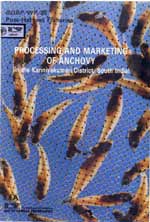|
PREFACE
From 1989 to 1992, the Bay of Bengal
Programme’s (BOBP) Post-Harvest Fisheries Project, funded
by the Overseas Development Administration (ODA) of U.K., has
been working together with the Kanniyakumari District
Fishermen’s Sangams Federation (KDFSF) based in Nagercoil,
Tamil Nadu, India, to provide assistance in resolving several
problems associated with the traditional practice of drying and
marketing Anchovy. It was shown that losses in potential earnings
as a result of poor fish landing, spoilage and low product
quality were very significant. This was due primarily to the
local practice of drying the fish directly on the beach sand.
An analysis of the market, both domestic and
export, provided several important insights into the potential
for developing value-added and higher quality products based on
the existing, traditional kattumaram fishery. These have shown
that dried Anchovy is a highly desirable product amongst a wide
range of socio-economic groups in many countries, ranging from
West Asia through South Asia to Southeast Asia. Given quality and
presentational improvements, a quality premium is payable which
can mean a fivefold increase in the product’s wholesale
price.
Simple and low-cost drying racks made from
casuarina poles and second-hand netting were developed with the
participation of artisanal fishermen from Kanniyakumari. These
were demonstrated as being a technically and socio-economically
desirable means of achieving improvements in product quality and
providing a simple method of enhancing producers’
incomes.
This paper describes not only the development
of the technical systems which have helped the KDFSF and
fishermen achieve these results. but also discusses the
methodologies and socio-economic considerations behind the
project. Emphasis is placed on analysing potential impact on the
target communities.
|
